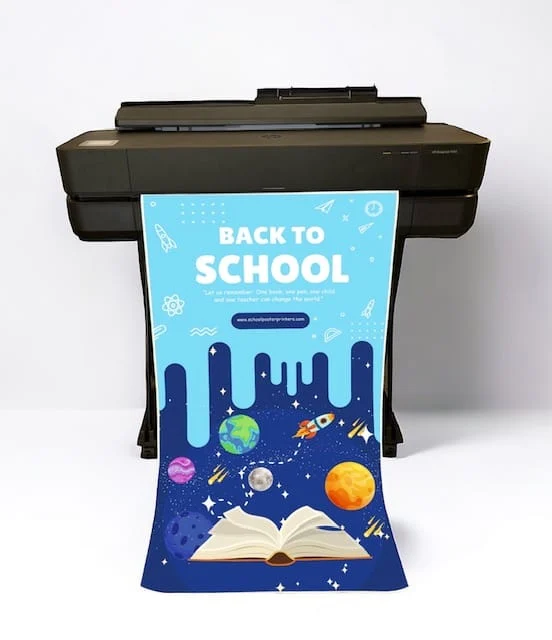Beyond the Ink: A Complete Guide to Poster Printer Paper for Stunning Prints

Learn about Poster Printer Paper and essential Poster Printer Supplies with this helpful guide, perfect for schools aiming to print high-quality educational materials using poster printing equipment.
Why Poster Printer Paper Matters More Than You Think
Many people assume that all printing paper is the same. In reality, the quality and characteristics of your poster printer paper can significantly affect the final output. The right paper ensures:
-
Brilliant color reproduction
-
Crisp, sharp images
-
Better ink absorption
-
Increased durability
-
A professional finish
Posters are meant to catch the eye and communicate a message effectively. Without suitable paper, even the most stunning design can fall flat.
Types of Poster Printer Paper
Poster printer paper is available in various types, each designed for specific applications and print goals. Here are the most popular options:
1. Glossy Paper
Glossy paper has a shiny surface that enhances colors and contrast. It is ideal for photo-rich posters, such as movie posters or promotional materials that require high visual impact.
Pros:
-
Vibrant color reproduction
-
Smooth and professional finish
Cons:
-
Prone to fingerprints
-
Can produce glare under lighting
2. Matte Paper
Matte paper has a non-reflective surface, making it ideal for posters that are meant to be viewed under bright lights or from multiple angles.
Pros:
-
No glare or reflections
-
Excellent for text-heavy or detailed designs
Cons:
-
Colors appear slightly muted compared to glossy finishes
3. Satin or Semi-Gloss Paper
This paper is a compromise between glossy and matte. It offers moderate shine without the harsh glare and works well for both images and text.
Pros:
-
Balanced finish
-
Versatile for various designs
Cons:
-
May still reflect light under direct exposure
4. Canvas Paper
Canvas paper mimics the texture of canvas, giving posters a fine art feel. It’s ideal for artistic prints, illustrations, and high-end décor posters.
Pros:
-
Textured, artistic feel
-
Durable and thick
Cons:
-
More expensive
-
Requires pigment-based inks for best results
Paper Weight and Thickness: What You Should Know
The weight of poster printer paper is measured in GSM (grams per square meter). The higher the GSM, the thicker and more durable the paper.
-
120–150 GSM: Thin and flexible, suitable for short-term posters or indoor use.
-
180–200 GSM: A middle ground—sturdy enough for general poster use with decent durability.
-
230–300 GSM: Heavy-duty paper, great for outdoor use or posters that need to last.
Note: Thicker paper may not work in all printers, so check compatibility before purchasing.
Poster Sizes and Standard Dimensions
Poster printer paper comes in various sizes to accommodate different printing needs. Here are common poster sizes:
-
11” x 17” – Small posters or notices (Tabloid)
-
18” x 24” – Medium-sized posters, ideal for announcements
-
24” x 36” – Large format posters used for events or advertising
-
36” x 48” – Extra-large posters for maximum visibility
Wide-format printers can handle roll-based paper, which allows for custom sizing and larger prints.
Coated vs. Uncoated Paper: What's the Difference?
Coated Paper
Coated paper has a layer that improves ink absorption and sharpness. Glossy, satin, and matte papers are usually coated.
Ideal for:
-
High-resolution photo prints
-
Professional advertising posters
Uncoated Paper
Uncoated paper has a more natural feel and is more absorbent. It’s often used for posters that have a vintage or handmade look.
Ideal for:
-
Artistic or minimalist posters
-
Eco-conscious printing
Choosing the Right Poster Printer Paper for Your Project
To select the right paper, consider the following:
-
Purpose – Is the poster for display, advertising, education, or décor?
-
Location – Will it be indoors or outdoors? In a well-lit area?
-
Lifespan – Is it for a one-day event or a long-term installation?
-
Design – Does it feature photos, text, or illustrations?
-
Budget – Premium paper can be costly but adds a professional touch.
Eco-Friendly Poster Printing Options
As sustainability becomes more important, many companies and artists are turning to eco-friendly poster printer paper. These options may include:
-
Recycled paper
-
Tree-free paper made from bamboo or cotton
-
Biodegradable coatings
Using sustainable paper doesn’t mean compromising on quality—many green paper options are just as bright and durable as their conventional counterparts.
Ink Compatibility and Printer Types
Not all paper types are compatible with every printer. Consider whether you're using:
-
Inkjet Printers – Best for photo-quality prints and color posters
-
Laser Printers – Suitable for text-heavy and high-volume prints
-
Wide-Format Printers – Designed for large posters, can handle paper rolls
Tip: Use paper specifically designed for your printer type. For instance, inkjet-compatible glossy paper will not perform well in a laser printer.
Storage and Handling Tips
To preserve the quality of your poster printer paper:
-
Store it in a cool, dry place to avoid warping or curling.
-
Keep it in the original packaging to protect against dust and moisture.
-
Handle paper by the edges to prevent fingerprints or smudges.
-
Allow freshly printed posters to dry flat before framing or mounting.
Final Thoughts: Investing in the Right Poster Printer Paper
Choosing the right poster printer paper may seem like a small decision, but it can have a huge impact on the quality and effectiveness of your prints. Whether you're an artist looking to showcase your work, a business promoting an event, or a teacher creating educational visuals, your choice of paper reflects the professionalism of your brand and the clarity of your message.
- Art
- Causes
- Crafts
- Dance
- Drinks
- Film
- Fitness
- Food
- Jogos
- Gardening
- Health
- Início
- Literature
- Music
- Networking
- Outro
- Party
- Religion
- Shopping
- Sports
- Theater
- Wellness



